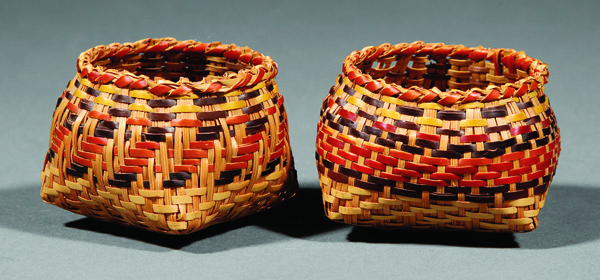Chitimacha Baskets
Deeply rooted in the history, spirituality, and daily activities of the Chitimacha people, basketry remains a visible expression of the Chitimacha Indian tribe’s culture and tradition.

Courtesy of Neal Auction Company
Two Chitimacha Single Weave Baskets. Darden Family (Artists)
For more than a century, members of the Darden family in St. Mary Parish, Louisiana, have served as keepers of the ancient tradition of Chitimacha split-cane basketry. Deeply rooted in the history, spirituality, and daily activities of the Chitimacha people, baskets created by the Dardens remain visible expressions of the Chitimacha Indian tribe’s culture and tradition.
Utilizing splints of river or swamp cane (Arundinaria gigantea), these artisans have created and incorporated intricately woven designs into their baskets, bearing names such as “alligator entrails,” “rattlesnake,” “muscadine rind,” “little trout,” and “worm tracks,” all recalling the natural world of South Louisiana. Chitimacha basketry is so true to its time-honored roots that a basket produced one hundred years ago is virtually indistinguishable from one produced today. This remarkable consistency may be attributed in part to the careful curation of heirloom pattern baskets passed down within the Dardens and other families of Chitimacha weavers.
Master weaver Clara Darden, who retained and passed on vast reservoirs of traditional knowledge during her lifetime, was over 100 years old when she died in 1910. Adele Darden (the granddaughter of the famed chief Soulier Rouge) and medicine woman Delphine Darden Stouff were also renowned bearers of Chitimacha basketry traditions. In the twenty-first century, three related weavers—spouses John Paul and Scarlett Darden, and John’s sister, Melissa Darden Brown—are practitioners and stewards of this family and tribal art form. Faced with diminishing natural resources and the loss of knowledgeable elders, these three weavers assumed the responsibility of ensuring that Chitimacha basketry traditions are maintained for the next generation.
The Dardens learned to make baskets from their grandmothers, Lydia Darden and Ernestine Walls, both master weavers and rigorous taskmasters. John, Scarlett, and Melissa learned in the traditional manner. Before they were allowed to weave, they logged miles and years by joining their elders in the gathering of cane, which has to be tall and strong and larger than a quarter in circumference. They watched as their grandmothers split and peeled each splint, using only their teeth and a sharp knife. The cane is then dyed the three colors that characterize Chitimacha basketry—red, black, and yellow—before being dried, stripped, and peeled again into fine, narrow straws for weaving. In earlier times, black walnut, red willow, and dock root were used; but by the mid-twentieth century, aniline dyes had taken the place of natural dyes.
Not until they were adults with children of their own did John, Scarlett, and Melissa begin to make baskets. Having observed, they imitated the craft of basket weaving, learning not by instruction but by trial and error. Forced by their elders to take apart what they had woven, tighten the weave, and rework loose corners again and again to improve their skills, the young weavers were schooled in the standards of excellence required by their teachers. They learned to ask the right questions in the right way, each critique carrying with it a valuable lesson. Working alongside their grandmothers, the weavers also learned about the Chitimacha people, the Darden family, and traditional tribal culture.
Today, each weaver is a recognized master, creating baskets using double- and single-weave techniques, crafting deep bowls with tightly turned corners along with elbow baskets and beautiful mats. Each basket tells a story about the Chitimacha people, and the signature red straw woven into the hem of each basket identifies a weaver from the Darden family.
Darden split-cane basketry may be found at the National Museum of the American Indian in Washington, D.C., the Peabody Museum of Archaeology and Ethnography at Harvard University, the Chitimacha Museum in Charenton, and private collections throughout the nation. The family members are regular participants at Festival Acadiens, the New Orleans Jazz and Heritage Festival, and Oklahoma’s Red Earth Native American Cultural Festival.
